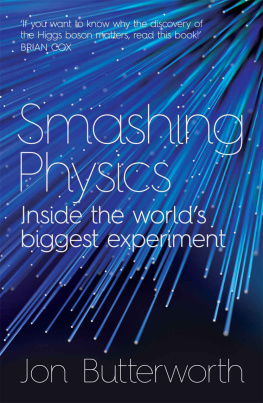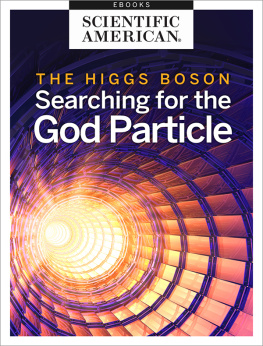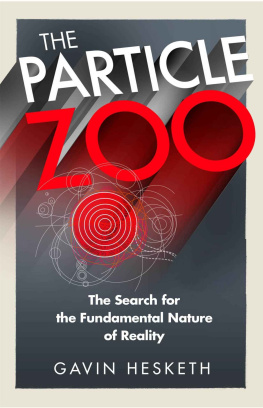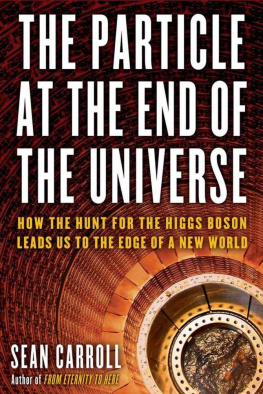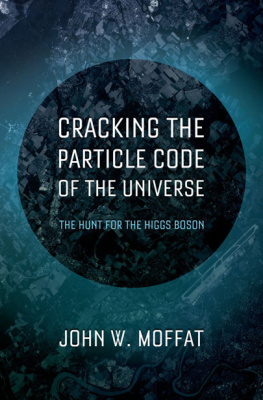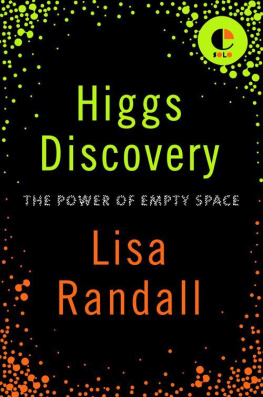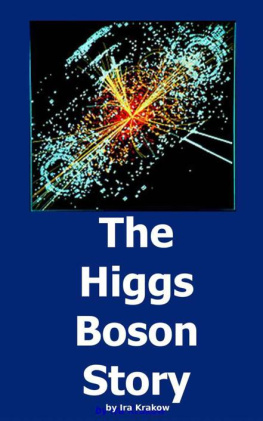SMASHING PHYSICS
Jon Butterworth

Copyright 2014 Jon Butterworth
The right of Jon Butterworth to be identified as the Author of the Work has been asserted by them in accordance with the Copyright, Designs and Patents Act 1988.
Apart from any use permitted under UK copyright law, this publication may only be reproduced, stored, or transmitted, in any form, or by any means, with prior permission in writing of the publishers or, in the case of reprographic production, in accordance with the terms of licences issued by the Copyright Licensing Agency.
First published as an Ebook by Headline Publishing Group in 2014
Cataloguing in Publication Data is available from the British Library
Epub conversion by Avon DataSet Ltd, Bidford-on-Avon, Warwickshire
eISBN 978 1 4722 1032 6
HEADLINE PUBLISHING GROUP
An Hachette UK Company
338 Euston Road
London NW1 3BH
www.headline.co.uk
www.hachette.co.uk
Contents
About the Book
The discovery of the Higgs Boson made headlines around the world. Two scientists, Peter Higgs and Franois Englert, whose theories predicted its experience, shared a Nobel Prize. The discovery was the culmination of the largest experiment ever run, the ATLAS and CMS experiments at CERNs Large Hadron Collider.
But what really is a Higgs boson and what does it do? How was it found? And how has its discovery changed our understanding of the fundamental laws of nature? And what did it feel like to be part of it?
Jon Butterworth is one of the leading physicists at CERN and this book is the first popular inside account of the hunt for the Higgs. It is a story of incredible scientific collaboration, inspiring technological innovation and ground-breaking science. It is also the story of what happens when the worlds most expensive experiment blows up, of neutrinos that may or may not travel faster than light, and the reality of life in an underground bunker in Switzerland.
This book will also leave you with a working knowledge of the new physics and what the discovery of the Higgs particle means for how we define the laws of nature. It will take you to the cutting edge of modern scientific thinking.
About the Author
Jon Butterworth is a leading physicist on the Large Hadron Collider, and Head of Physics and Astronomy at UCL. He writes the popular Life & Physics blog for the Guardian and has written articles for a range of publications including the Guardian and New Scientist . Jon often discusses physics in public, including talks at the Royal Institution and the Wellcome Trust and appearances on BBC Radio 4s Today Programme, The Infinite Monkey Cage, BBC Newsnight, Horizon, Channel 4 News and Al Jazeera. He was awarded the Chadwick Medal of the Institute of Physics in 2013 for his pioneering work in high energy particle physics, especially in the understanding of hadronic jets.
To Susanna, Leon, Felix and Edie
A science is any discipline in which the fool of this generation can go beyond the point reached by the genius of the last generation.
Max Gluckman
Introduction
There is a kebab restaurant in the Meyrin suburb of Geneva that has half a dozen pool tables. In early July 2012, I found myself playing pool with Tom Clarke, the science correspondent of Channel 4 News, by way of trying to explain to him and his viewers the significance of the discovery we had just made at the Large Hadron Collider.
I still find that last sentence amazing both the discovery and the huge public interest demonstrated by the fact that Tom, along with many other journalists, came out for a day and spoke to dozens of physicists. His report was the lead item on the 4 July bulletin.
The discovery we announced that day was a huge step forward in physics. The public interest was a significant milestone in peoples increasing engagement with the science that lies behind our civilisation. I really mean the science, not just the technology but the processes of science to what extent it is self-correcting, and what constitutes scientific certainty (very little!) and scientific knowledge (a lot!).
Meyrin is significant here because CERN, the European laboratory for particle physics, is just five minutes up the road. Meyrin village is quite picturesque, but the part Tom and I were in, Cit Meyrin, is a series of blocks of flats that would be a urine-smelling, graffiti-ridden concrete jungle pretty much anywhere else in the world. However, because this is Switzerland (just by about 100m) it is a clean, orderly concrete jungle. It is also where many of the scientists working at CERN stay.
I work for University College London (UCL), but, along with many particle physicists from all over the world, I do most of my research at CERN. The UCL commuter flat is in Meyrin, and my colleagues and I spend a lot of time there. In particular, I ran a working group on the ATLAS experiment at CERN from October 2010 to October 2012, the period during which we got our first flood of high-energy data. During that time, I was there more or less every week.
This book is not a physics textbook; it is not a historical account of the discovery of the Higgs boson; it is not a diary; and it is not a manifesto for greater engagement between scientists and the general public. It does contain elements of all these things, however. You will learn a lot about particle physics and what it is like to be a particle physicist, about how science works (and occasionally doesnt), about how research sometimes struggles to thrive and survive, and about the people who do it, including a bunch of personal opinions from me. I hope it will also explain why Tom Clarke and much of the worlds media descended on Meyrin that July.
To get that far, though, I need to introduce a number of interconnected and probably unfamiliar pieces of information. Some of them wont seem very relevant the first time they appear, like isolated pieces of a jigsaw puzzle, but as you collect them through the book, hopefully they will start to reinforce each other and in the end the full picture will emerge. And if I succeed, youll have fun as you follow the story collecting the pieces and gain a sense of excitement. Because fun and excitement are the two impressions that dominate my memory of the first high-energy run of the biggest scientific apparatus ever constructed: the Large Hadron Collider.
ONE
Before the Data
1.1 Why So Big?
The Large Hadron Collider (LHC) sits in a tunnel 27km long and about 100 m underground. If you know London, it might help you to know that 27 km is about as long as the Circle Line on the Underground, and the tunnel itself is similar in size to the Northern Line. If that doesnt help, then try this.
Imagine setting off from Meyrin, on the SwissFrench border near the airport, and driving towards the French countryside. The Jura Mountains are in front of you, Geneva Airport is behind. As you pass the border, you also pass the main site of the CERN laboratory on your left, and if you look to the right you will see a big wooden globe that looks like a sort of eco-nuclear reactor (its not, its an exhibition space, though it is eco-friendly, apparently), and you might catch a glimpse of the building housing the control room of the ATLAS experiment. You will know it if you see it, because it has a huge mural of the ATLAS detector itself on the wall.
Big though it is, the mural is painted to only one-third scale. ATLAS is very large, and is hidden underground, positioned at one of the interaction points of the LHC. These are the points where the two highest-energy particle beams in the world are brought into head-on collision. ATLAS is one of the two big general-purpose particle detectors designed to measure the results of these collisions.
Next page
